ENTASYS 200 case studies
This article shows computer-generated sound coverage plots for a variety of common applications using Community ENTASYS loudspeakers. Each coverage plot reveals the real world dispersion capabilities of an ENTASYS 200 system in a specific environment. By studying the coverage patterns in this article, it will be possible to design systems for alternate environments that are similar to the ones depicted. Biamp recommends using acoustical simulations to aid in designing loudspeaker systems whenever time and budget permit.
Introduction
ENTASYS 200 column loudspeakers are innovative products offering entirely new possibilities for solving difficult acoustical problems with ease, both indoors and outdoors. Available in four sizes, the ENTASYS 200 models have been engineered to serve the wide range of applications routinely encountered by professional sound contractors. Possessing advanced features, highly-focused dispersion patterns, and weather resistant construction, ENTASYS 200 columns make installations not only fast and simple, but as functionally effective as possible.
The modern, unobtrusive appearance of ENTASYS 200 columns means they will blend into virtually any room décor without calling undue attention to the technology behind the sound. All models can be ordered in either black or white finishes. They may also be field-painted to match a specific color scheme or room design. Each ENTASYS 200 model includes an appropriately-sized mounting bracket, a built-in 70V/100V autoformer for constant voltage applications, and an integral safety rigging point. Accessories include a universal mounting kit for use with third-party mounting brackets, and a stand adapter kit with an attachable tripod-stand mount that serves double duty as a handle for portable usage.
Product family overview
The ENTASYS 200 family begins with two small column loudspeakers, the ENT203 and ENT206. Powerful, but unobtrusive, these models are intended for use as foreground and background music, fill loudspeakers, ‘delay’ support of larger systems, and as the primary PA in small environments. The two larger models, the ENT212 and ENT220, are designed for use in medium to medium-large spaces. Highly effective when used as the main system, they can also be matched up with conventional point source loudspeakers, such as the I SERIES or V SERIES models. Their very narrow vertical dispersion precisely directs sound to specific room regions, thereby complementing the inherently broader dispersion of point source loudspeakers.
All models may easily be augmented with subwoofers. Subwoofers will significantly extend the low frequency response of an ENTASYS 200 system, while also increasing the power output capability of the ENTASYS columns. Community ALC and Biamp amplifiers are the perfect complement to any ENTASYS 200 system installation, whether used with or without subwoofers. The ENTASYS 200 models provide a modern solution to the age old problem of directing sound where it is needed - and nowhere else. By reducing room reflections, musical clarity and speech intelligibility are greatly improved.
Cafeteria - Gymnasium
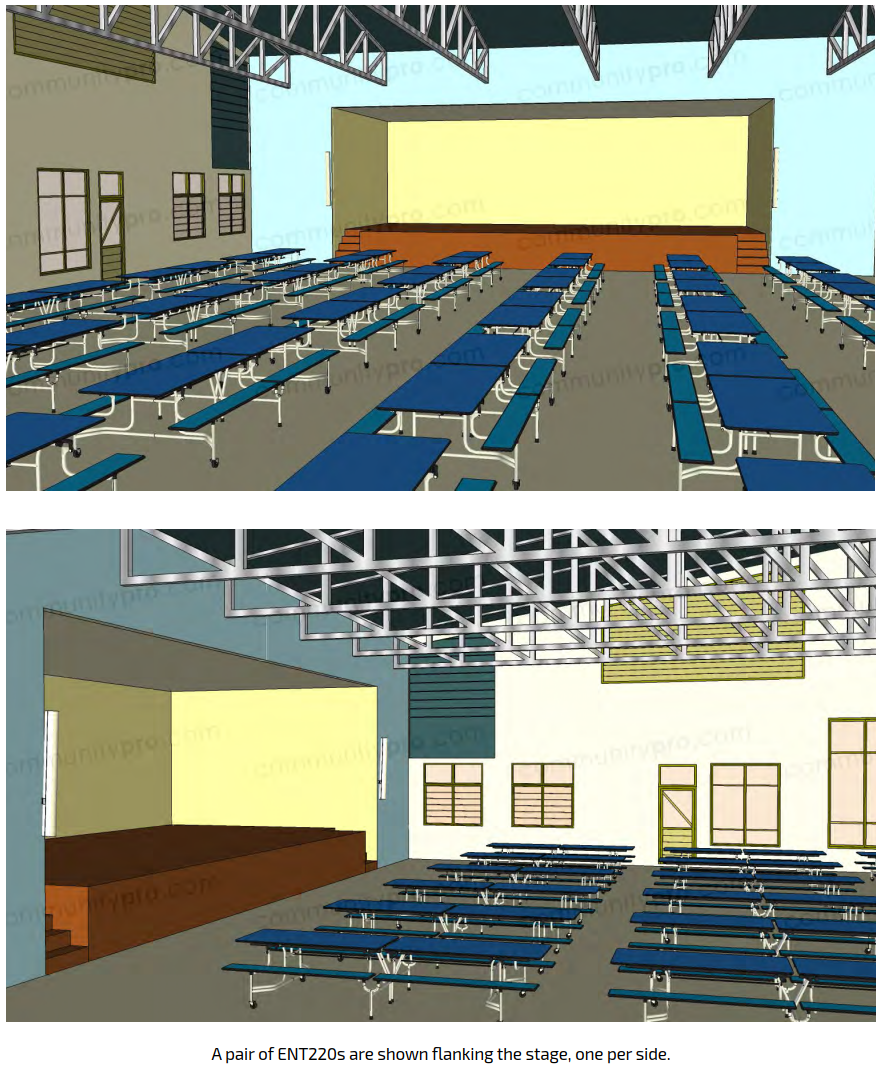
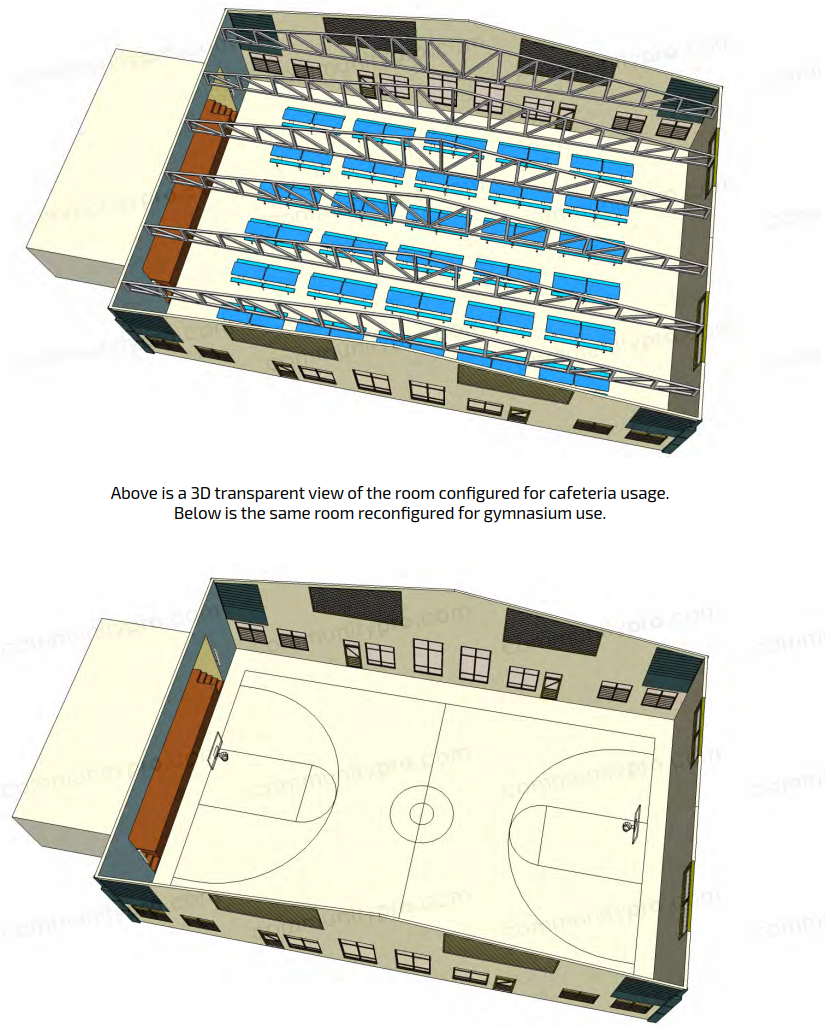
The computer model shown below depicts the predicted sound pressure levels (SPL) from the front of the room to the rear of the room. The vertical bar to the right of the rendering correlates volume level in dB with the colors shown in the computer model.
This design is based on a single pair of ENT220s located on each side of the stage house. Note how the volume levels are not only consistent, but virtually identical throughout the room, due to the ENT220 column loudspeaker’s unique properties.
A larger room equipped with bleachers may require additional column loudspeakers facing the audience members, the location of which would be based on the specific room geometry. If track playback of music, or a live musical performance is anticipated, one or two subwoofers should be included in the system design. They should be located in close proximity to the column loudspeakers in order to achieve good summation throughout the crossover region.
During installation and commissioning, the downward tilt of the column loudspeakers should be carefully adjusted to avoid excess sonic energy from reflecting off of the rear wall surfaces.
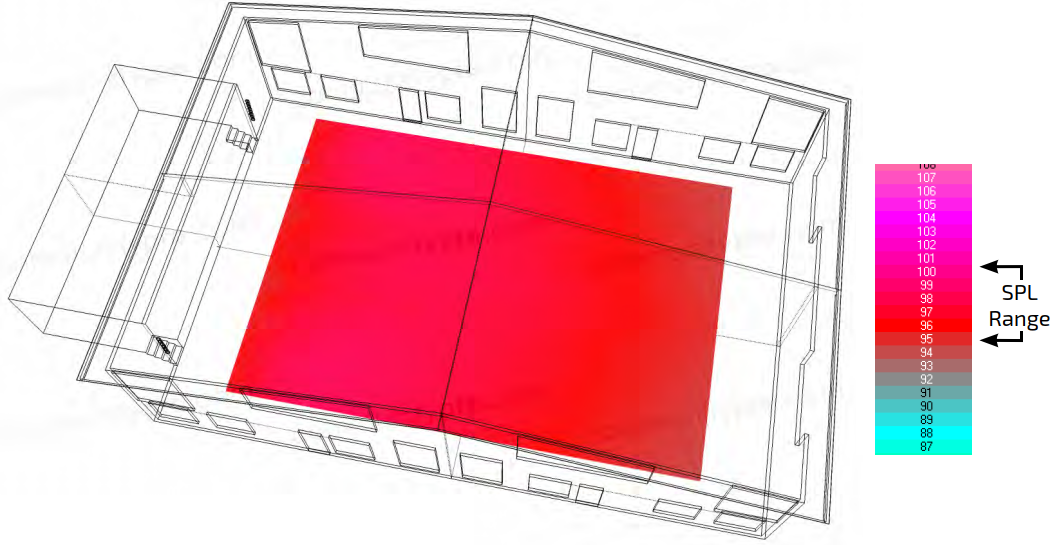
Typical Hotel Ballroom
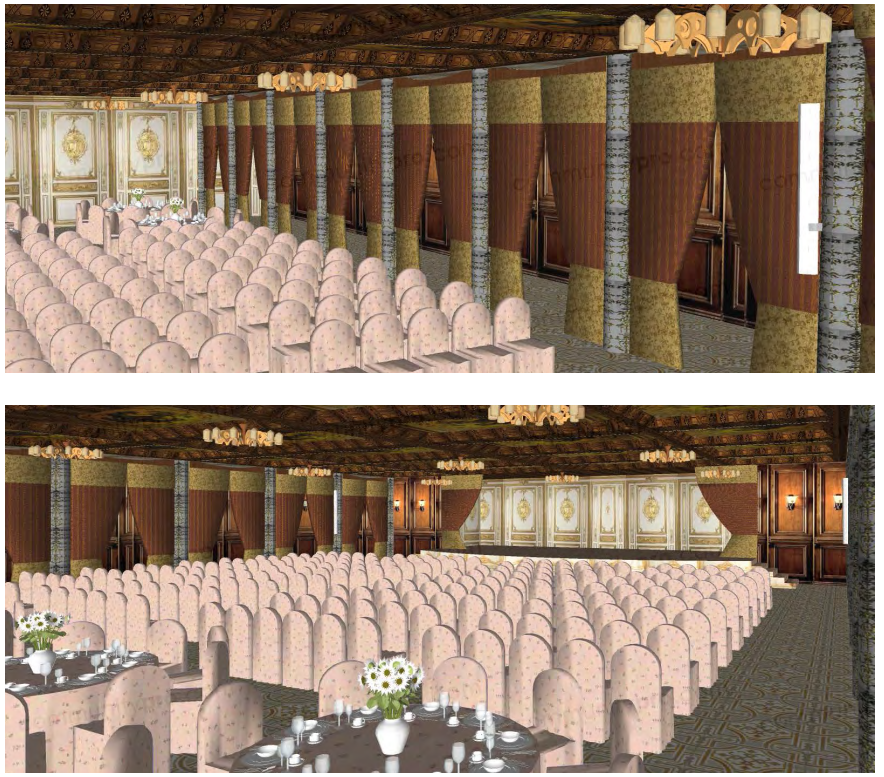
ENTASYS 200 column loudspeakers are well suited for use in ballrooms, junior ballrooms, as well as small, medium and large meeting rooms. Because such venues often have high ceilings, speech intelligibility will be enhanced by keeping sonic energy directed to the audience members and away from the ceiling surfaces.
In smaller rooms, a single pair of ENT212s flanking the stage will usually suffice, and can be augmented with a subwoofer if live music or track playback is part of the anticipated program material. In medium sized rooms, a pair of ENT220s is a more appropriate choice, again augmented by a subwoofer, if needed. In large rooms it is recommended to include ENT203s or ENT206s, possibly as many as three or four pair, located on the side walls towards the middle and middle rear of the room, and fed by a delay line. This will improve the front-to-rear coverage uniformity.
Almost all ballrooms can be reconfigured quickly from classroom-style seating to banquet-style seating, and often the Head Table will be placed at the side of the room instead of at the front. This will require a second set of column loudspeakers positioned so that they flank the Head Table, and usually an additional subwoofer. It’s very important that the sonic energy emanates from where the presentation is originating.
The computer model shown below depicts the predicted sound pressure levels from the front of the room to the rear of the room, and also includes the levels
on the stage. The vertical bar to the right of the rendering correlates level in dB with the colors shown in the various sections of the room. There are two key points of interest:
First, the sound pressure level on the stage is much lower than the sound pressure level in the room, by about 10 dB. Only at the front of the stage does the level begin to pick up slightly. This indicates that feedback will be well controlled, and that lecturers and musicians on stage will hear very little spill from the ENTASYS 200 column loudspeakers. (Note: the column loudspeakers are installed on the architectural pillars located second from the front of the room, downstage from the stage house. As can be seen in the rendering they are unobtrusive, blending in well with the room décor).
Second, the uniformity of level from the front of the room to the rear of the room is exceptionally even, deviating by only a few dB. This ensures that audience members who are seated towards the front will not be overpowered by excessive volume, while those seated in the rear of the room will not be struggling to hear properly.
A larger room or a deeper room may require supplemental delay loudspeakers, such as ENT206s. These would be located on pillars part way into the room, about five or six positions on pillars from the front. During installation and commissioning, the downward tilt of the column loudspeakers should be carefully adjusted to avoid excess sonic energy from reflecting off of the rear wall surfaces.
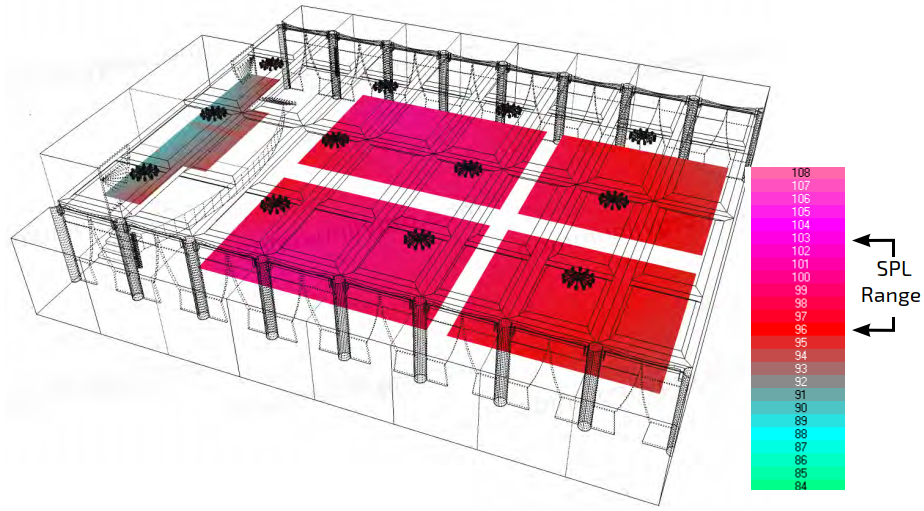
A pair of ENT212s are located on the pillars that are second from the front, one per side.
Boardroom
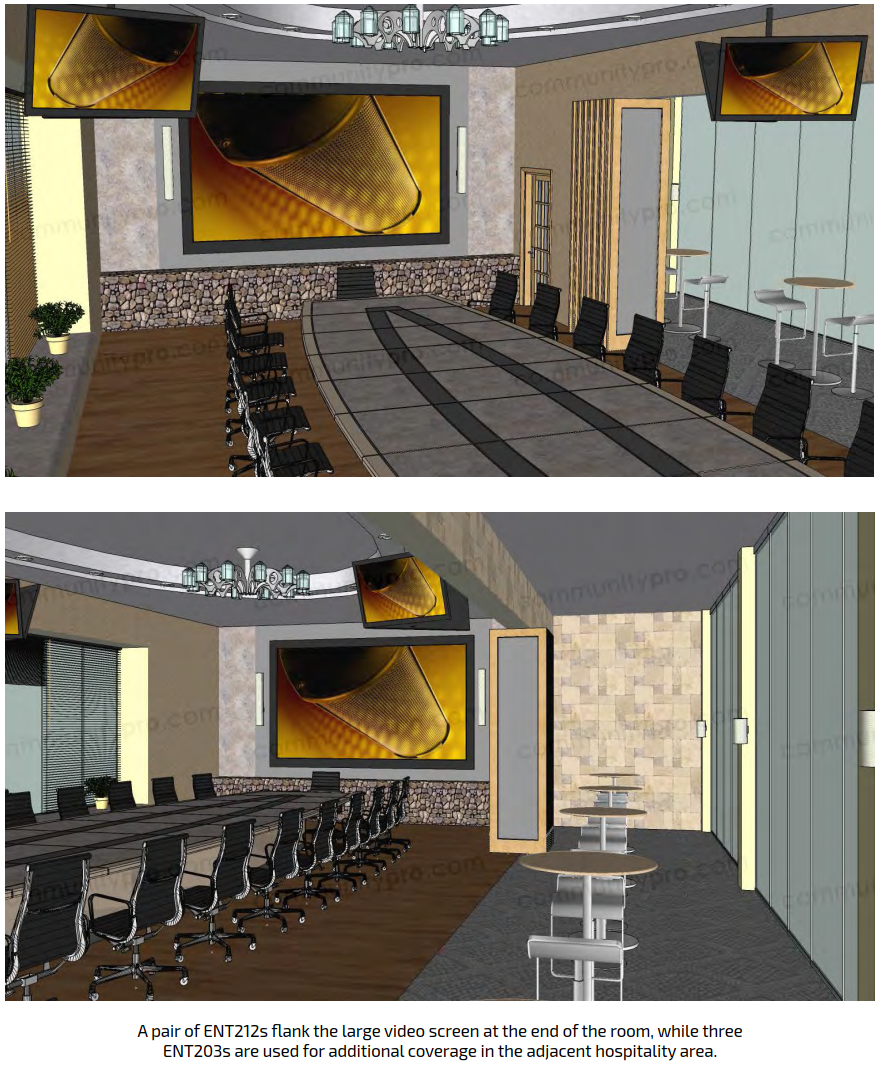
This design is based on a pair of ENT212s that flank the large video screen at the end of the room, supported by three ENT203s in the hospitality area. If the hospitality area is not acoustically isolated from the main meeting room, then it is strongly recommended that the ENT203s’ each be delayed, so as not to produce conflicting arrival times that could harm intelligibility.
Modern business presentations are often accompanied by video productions with dynamic soundtracks; if such program material is anticipated, a subwoofer should be included in the system design located under the large video screen. During installation and commissioning, the downward tilt of the column loudspeakers should be carefully adjusted to avoid excess sonic energy from reflecting off of the rear wall surfaces.
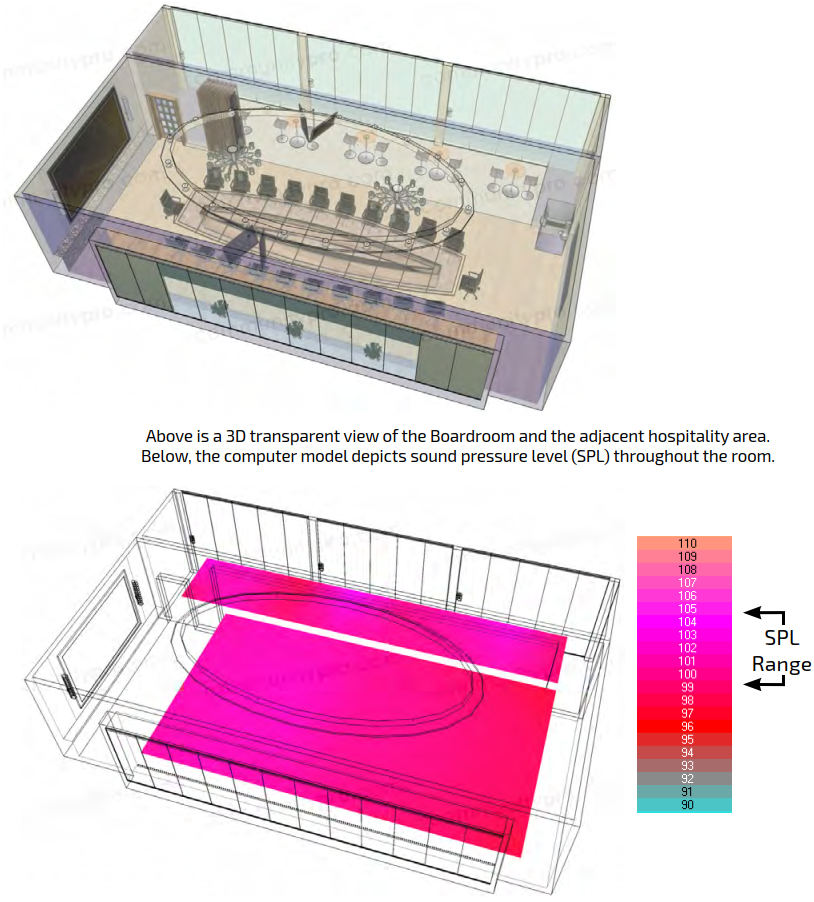
House of Worship I
This example is of a medium sized church with seating on the main floor, a small balcony in the rear, and additional seating on the left and right sides of the floor that face inwards. ENTASYS 200 column loudspeakers are ideally suited for coverage in rooms of this type. The different sized models can be selected to provide appropriate coverage in the various areas of the sanctuary, while being practically invisible to the worshippers.
In this example, a pair of Community’s ENTASYS FRs have been located on each side of the stage to cover the front four pews on the main floor and to provide ‘imaging’ so that the attention is drawn to the front of the church. A second pair of ENTASYS FRs are located on the side walls of the church, used with a delay line, for coverage from the fifth row of pews rearward.
A pair of ENT206s, one per side, provide coverage to the pews that face inward. A second pair of ENT206s are located at either side of the balcony, also used with a delay line. This configuration provides near-perfect uniformity in level, as shown in the computer generated rendering on the following page.
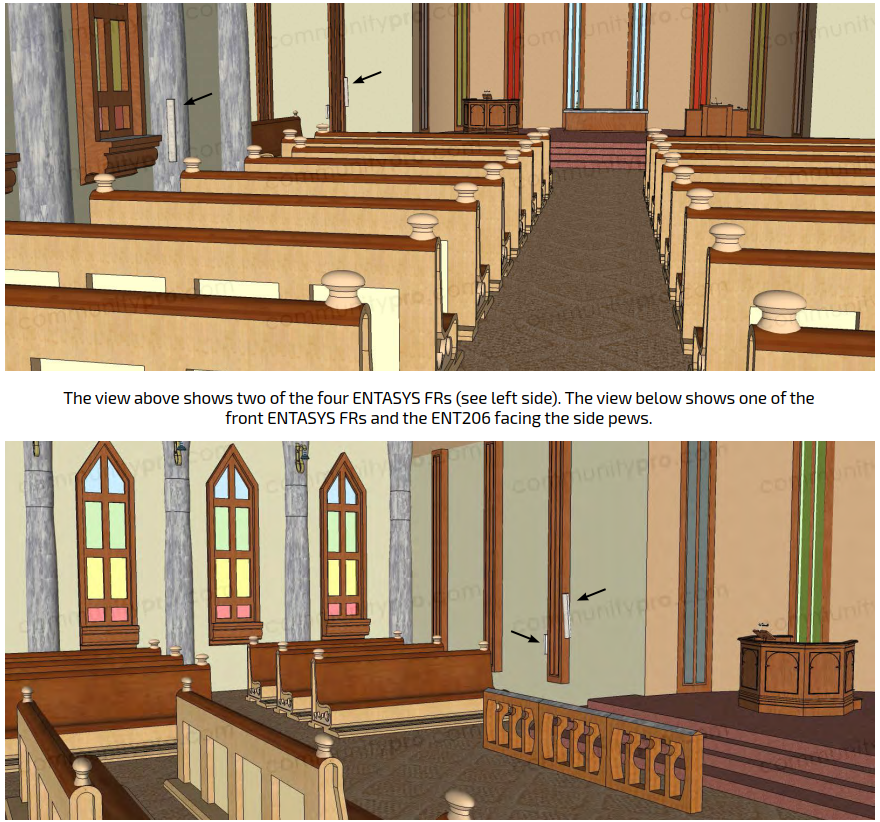
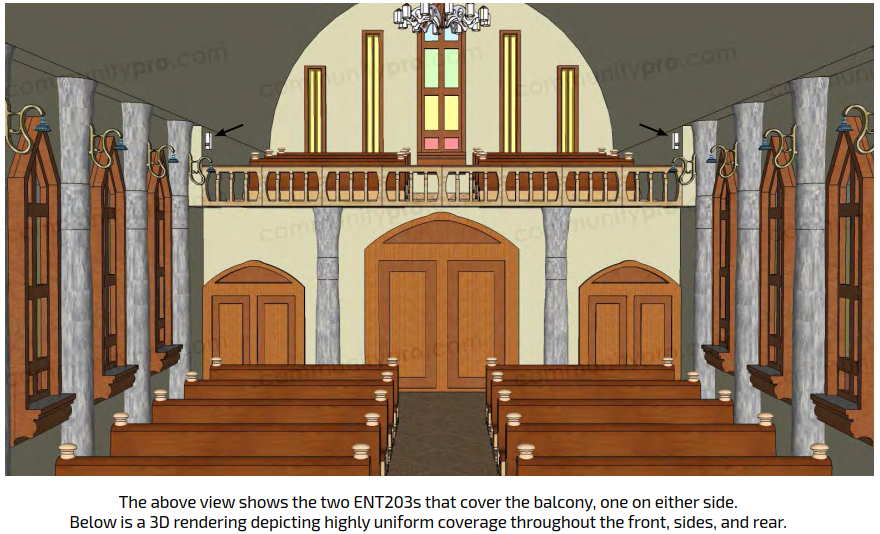
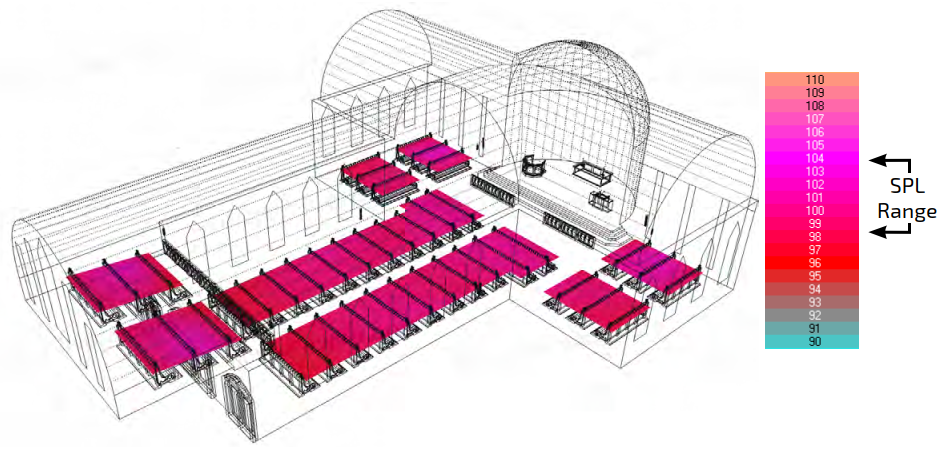
House of Worship II
This example is of a small-sized church of 80 seats. The room geometry is somewhat complex with forward-facing pews on the main floor, and a balcony that wraps around the side and the rear. On both sides the pews in the balcony face inward. ENTASYS 200 column loudspeakers are ideally suited for coverage in rooms of this type, while being practically invisible to the worshippers.
In this example, a pair of ENT212s have been positioned on each side of the stage that cover all twelve pews on the main floor. A second pair of ENT212s are located directly above the first pair, about two meters higher. This second pair of loudspeaker columns covers the full wraparound balcony.
The configuration provides good uniformity in level from a simple system that’s easy to install. The computer generated simulation on the following page reveals a front to rear volume level differential of about 6dB.
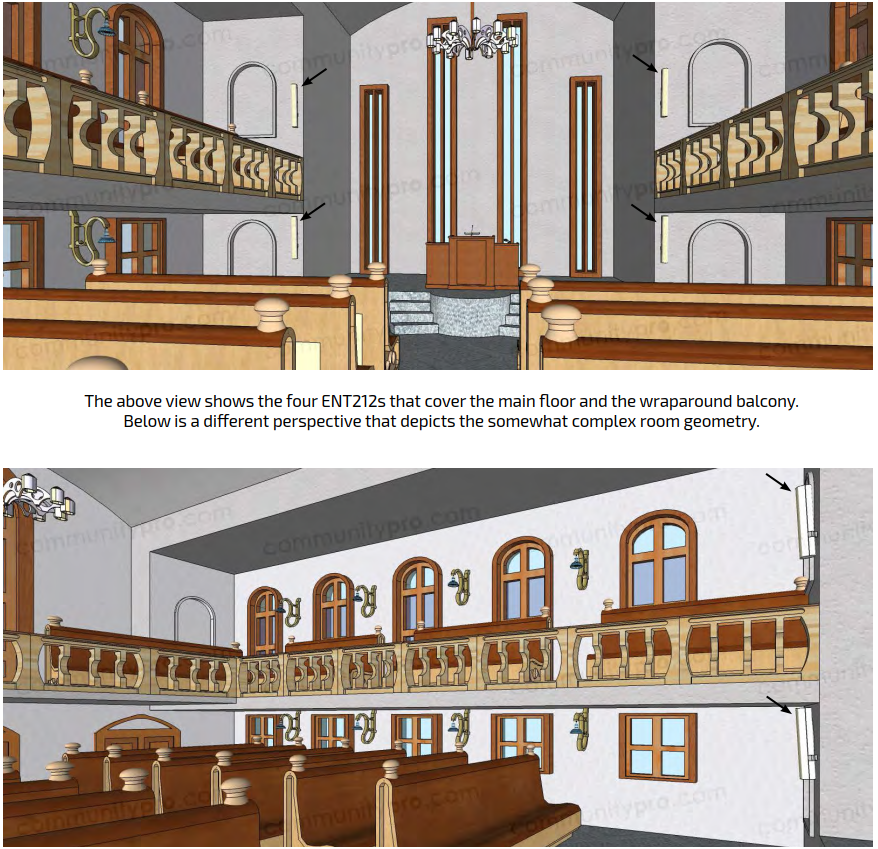
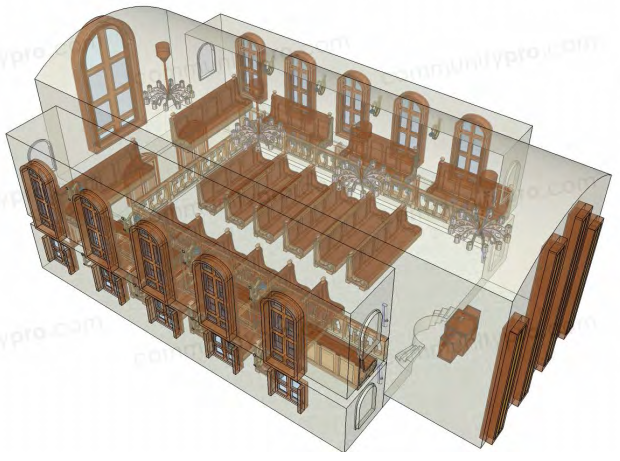
Above is a 3D transparent rendering of the building. Below is a computer simulation showing very good level uniformity throughout the main floor and wraparound balcony.
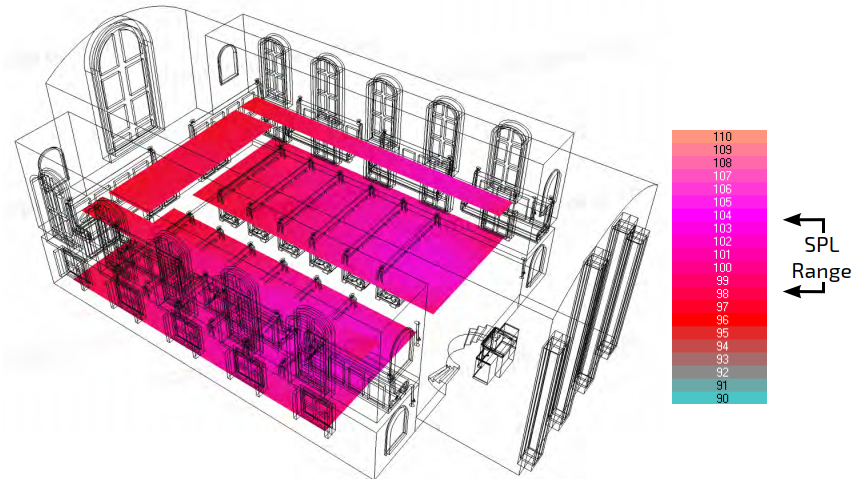
Transit Station
The train station in this example utilizes construction that is common to many; the walls are typically concrete, brick, or cement block, the floor is never carpeted, and the ceiling is either domed glass (as shown), concrete, or metal. The result is a formula for significant acoustical reflections. Traditional paging systems are often entirely unintelligible in some, or even all, sections of many stations. Yet, it is very important for travelers to clearly hear announcements of track changes to stay on schedule, and even more important to hear instructions if an emergency occurs and they are directed to egress towards a certain exit.
By providing highly-directed sound that keeps harmful reflections from bouncing off the walls, floor and the ceiling, and scattering throughout the room, the ENTASYS 200 system depicted in this example is capable of providing excellent intelligibility, far superior to that of the oft-utilized paging horn solution. As a side benefit, ENTASYS 200 columns can provide the additional benefit of supporting the video screens with high quality audio, and/or background music.
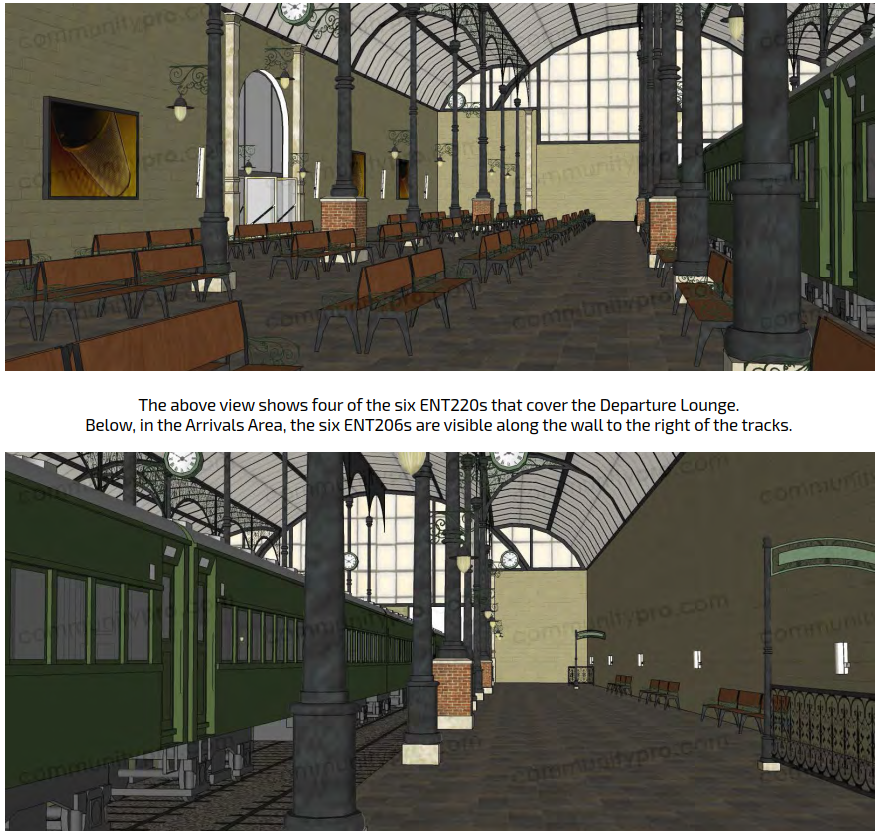
The system consists of six ENT220s in the Departure Lounge, the larger of the two sections. The columns are located on the wall that faces the train tracks; each pair flanking one of the three video screens. On the opposite side of the tracks, in the smaller Arrivals area where passengers tend to move quickly towards the exits, coverage is handled by six ENT206s. In Arrivals there are no video screens in this example.
The key to providing uniform coverage and intelligibility is to critically determine the optimal height and downward tilt of the ENTASYS column loudspeakers. Computer simulation is highly recommended for potentially problematic rooms of this type.
The computer model shown below indicates exceptionally even coverage throughout the room, and enough SPL (sound pressure level) to overcome the noise of approaching and departing trains.
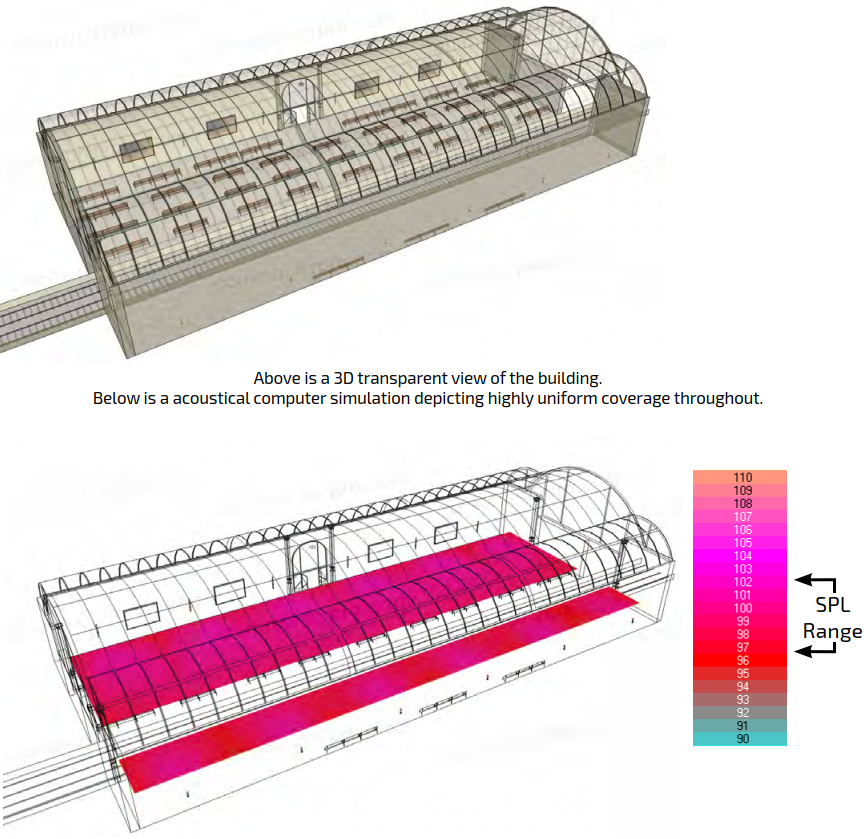
Bar - Restaurant
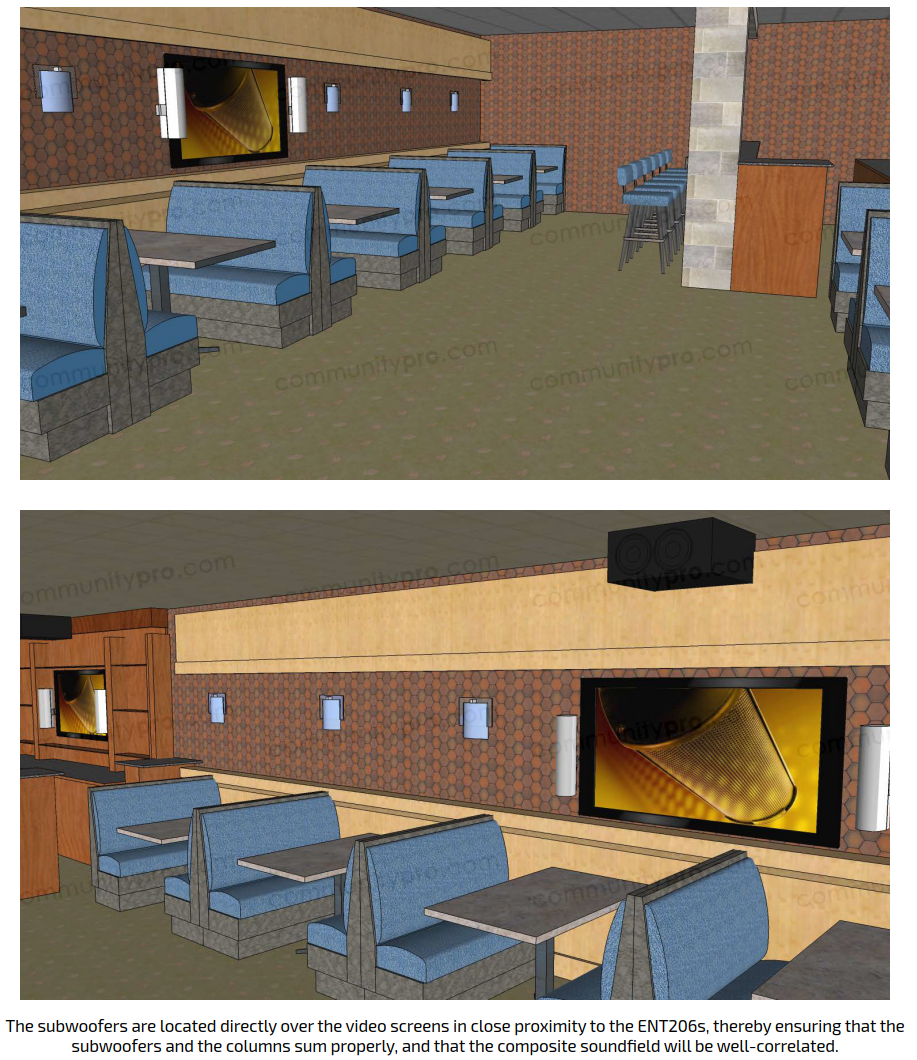
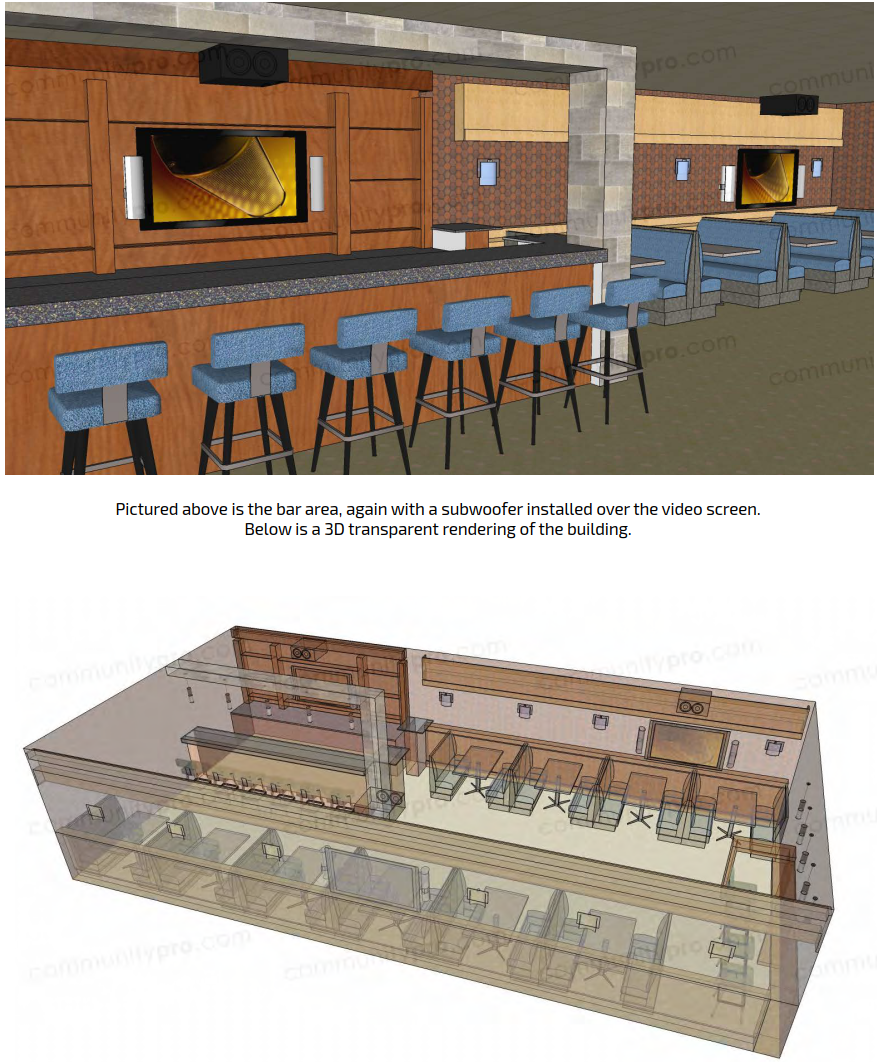
ENTASYS 200 column loudspeakers are an excellent choice for bar and restaurant environments due to their superior sound quality, their ability to project sound at a distance without overpowering patrons who are seated nearby, and because they come in a range of sizes—but with a common sonic signature. Larger models, often used to flank a video screen (as shown in this example), provide the primary source for clarity and intelligibility when used to reproduce video soundtracks, foreground music playback, and live presentations.
Smaller models can provide additional coverage in those seating areas that are located away from the coverage region of the primary source. Used in conjunction with one another, the sound levels in the room can be adjusted to be uniform and even throughout, as depicted in the computer model shown below. Alternately, if one or more quiet areas are intended for conversation, the ENTASYS 200 can easily fulfill that requirement as well, by using separate amplifier channels and adjusting levels appropriately, or by using taps on the built-in autoformer.
Modern bars and restaurants, especially those catering to a younger crowd, will almost always desire subwoofers, to provide extended bass response. Subwoofers should be kept as close in proximity as possible to the column loudspeakers, thereby supporting proper summation through the crossover
region, and a well correlated composite soundfield.
Establishments that have several distinct zones are excellent candidates for employing a Biamp Tesira Digital Signal Processors to complement the system installation. Level changes in different zones can be preset for different times of day, or different events, and altered with the touch of a button on a wall mounted controller without requiring any audio knowledge. Overall level can be controlled as well, within a range of preset parameters, also by means of a remote wall-mounted volume control. The full set of Tesira's many features can be found at Biamp.com.

Effective distance coverage comparison
The chart below shows the typical distances at which each of the four models of ENTASYS 200 loudspeakers can be expected to provide excellent quality results. Keep in mind, however, that windy conditions, as well as differences in temperature, humidity and elevation, will all play a role in how a given loudspeaker performs, especially at distances. This is known as atmospheric absorption and diffraction; the further the distance from the loudspeaker to the listener, the greater the effect that atmospheric conditions will have on performance.
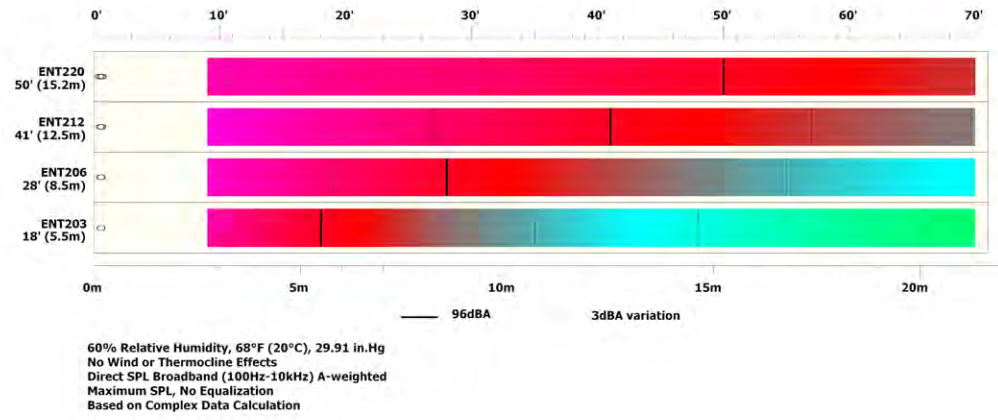
Summing it up
The examples in this article are intended to represent a range of typical usages for ENTASYS 200 column loudspeakers. In no way do they cover all possible applications; there are numerous others such as theatres, auditoria, resorts, theme parks, retail spaces, press boxes, ballpark concourses..., all limited only by the imagination.
Acoustical computer modeling is a powerful tool that helps the sound system designer make informed choices when determining the appropriate number of loudspeakers to use, where they should be located for maximum coverage and uniformity, selecting optimal pan-and-tilt angles, and predicting maximum SPL.
The case studies are presented (and intended) as “food for thought,” rather than hard and fast designs that must be adhered to. Thus, the basic design principles and performance expectations can be utilized for many applications and room styles that are not directly covered in this guide. The additional technical information is offered for better understanding of directivity and focusing.
By studying the design examples and allowing for variations in room geometry, it will be possible to make qualified design decisions. We do recommend utilizing predictive computer modeling to achieve the best possible results, whenever possible.
Our Loudspeaker Solutions Group (LSG) within the Biamp Applications Engineering team stands ready to answer questions and assist with design and installation recommendations; however, we do not replace the work of qualified consultants nor that of experienced contractors.
LSG Applications Engineering can be reached by phone at 877-242-6796 or contacted via email at support@biamp.com.

